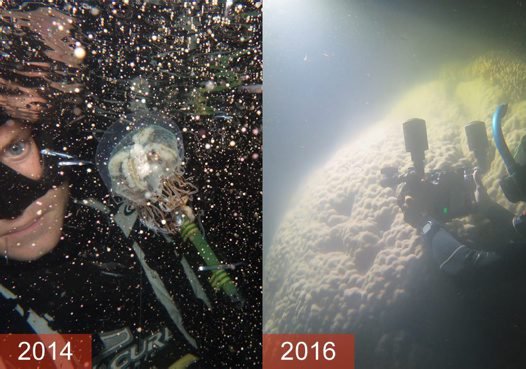Early coral spawning this year
The Acropora event normally takes place here on the fourth, fifth or sixth night after the full moon so this early spawning took researchers by surprise. Luckily they already had corals in the aquarium and were ready to do what they needed to do with the spawn when it happened at about 10 pm.
For only the second time in twenty years, we hadn’t organised a general night dive for visiting scientists at LIRS to observe the coral spawning. This was disappointing as we were planning on it, but too late! Researchers who are here to study the event normally do so in the aquarium, where corals will spawn at the same time as those on the reef. But everyone else who hasn’t seen it before (and more than a few who have) are keen to see it happening in the wild.
We usually go out at about 8.30 pm on the night we think it will happen, using several boats to get to a nearby site where both divers and snorkellers can get a good view. It is always totally dark as the moon hasn’t yet risen. Usually there is some spawn in the water when we arrive but the main event takes place a bit later, between about 9 and 10 pm. As soon as a snorkeller spots spawn “setting” in the coral polyps, everyone jumps in for a very special dive, to become immersed in a biological soup. As well as corals, other invertebrates such as brittlestars and sea urchins are also spawning and polychaete worms, themselves engaged in a reproductive event, swim like ribbons through the slowly-rising balls of coral spawn.

© Australian Museum
The more-or-less synchronous coral spawning on the Great Barrier Reef was discovered in the early 1980s. Several researchers working on different aspects of coral biology all came to the conclusion that “their” corals were going to reproduce at the same particular time. So they spread out along the GBR at the appointed time to see what happened - and found that it is indeed a highly synchronous and spectacular event across a very large number of coral species.
Since then, it's been found that the corals on the Great Barrier Reef use several cues to synchronise their spawning: winter temperatures determine the month (for example, if it's been particularly cold they might go in December rather than November), the lunar cycle determines the day (at Lizard Island, 3 to 7 nights after the full moon), and sunset determines the time (about 3 hours after sunset - in the aquarium, corals can be tricked into spawning early by putting them into the dark up to three hours before sunset). By following these cues, corals spawn at a good time for reproductive sucess: the water is warming rapidly as summer approaches, it's very dark, and tidal movement is as low as it gets.
Three research teams are at LIRS this year to take advantage of the coral spawning.
Dr Andrew Baird and colleagues from the ARC Centre of Excellence for Coral Reef Studies are comparing the size and lipid content of eggs between common and rare coral species. Their multi-year study of coral demography aims to determine the adaptive capacity of coral populations to climate change.
Prof Ralph Tollrian and PhD students Linda Weiss and Sebastian Striewski of the University of Bochum are investigating the effects of ocean acidification on coral larvae and newly-settled corals. They are raising larvae obtained from the spawning under three different carbon dioxide levels (current and predicted future levels) and are measuring larval survival, settlement and rate of early colony formation.
Melanie Trapon, a PhD student at James Cook University, is raising coral larvae in the aquarium and soon they will settle onto tiles. She will then set the tiles out onto the reef in different orientations to determine survivorship of recruits and early growth rates of colonies.

